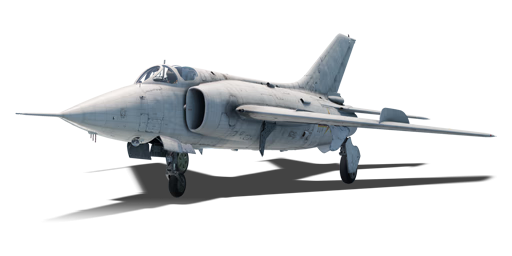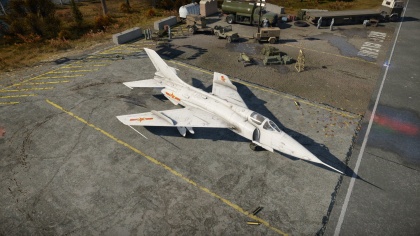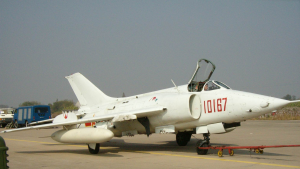Difference between revisions of "Q-5A"
Bonisducks (talk | contribs) (→External links: Done history and references.) (Tag: Visual edit) |
(Edits) |
||
| Line 163: | Line 163: | ||
== History == | == History == | ||
<!-- ''Describe the history of the creation and combat usage of the aircraft in more detail than in the introduction. If the historical reference turns out to be too long, take it to a separate article, taking a link to the article about the vehicle and adding a block "/History" (example: <nowiki>https://wiki.warthunder.com/(Vehicle-name)/History</nowiki>) and add a link to it here using the <code>main</code> template. Be sure to reference text and sources by using <code><nowiki><ref></ref></nowiki></code>, as well as adding them at the end of the article with <code><nowiki><references /></nowiki></code>. This section may also include the vehicle's dev blog entry (if applicable) and the in-game encyclopedia description (under <code><nowiki>=== In-game description ===</nowiki></code>, also if applicable).'' --> | <!-- ''Describe the history of the creation and combat usage of the aircraft in more detail than in the introduction. If the historical reference turns out to be too long, take it to a separate article, taking a link to the article about the vehicle and adding a block "/History" (example: <nowiki>https://wiki.warthunder.com/(Vehicle-name)/History</nowiki>) and add a link to it here using the <code>main</code> template. Be sure to reference text and sources by using <code><nowiki><ref></ref></nowiki></code>, as well as adding them at the end of the article with <code><nowiki><references /></nowiki></code>. This section may also include the vehicle's dev blog entry (if applicable) and the in-game encyclopedia description (under <code><nowiki>=== In-game description ===</nowiki></code>, also if applicable).'' --> | ||
| − | The Nanchang Q-5A | + | The Nanchang Q-5A 'Fantan' was the first variant of the Chinese ground attack aircraft, which has seen over 50 years of continuous service.<ref name=":0">Peck, M. (2019)</ref> Developed in the early 1950s as a replacement for ageing Soviet-made [[IL-10 (1946) (China)|IL-10]] attack aircraft, the plane was developed from the MiG-19 airframe. Though it entered service relatively late due to the effects of the Cultural Revolution, it still saw extensive service as the primary attack aircraft of the Chinese Air Force. As well, it was exported to several countries including Pakistan, Bangladesh, and Myanmar. Though it has now been retired from active Chinese service, the aircraft remains in service with the Myanmar Air Force.<ref name=":0" /><ref name=":1">Eastern Order of Battle. (n.d.)</ref> |
=== Design and development === | === Design and development === | ||
| − | In the early 1950s, China lacked and needed a new ground attack aircraft. While other nations were re-equipping with advanced attack aircraft such as the [[A-4B|A-4 Skyhawk]] and [[F-100A (China)|F-100 Super Sabre]], the Chinese | + | In the early 1950s, China lacked and needed a new ground attack aircraft. While other nations were re-equipping with advanced attack aircraft such as the [[A-4B|A-4 Skyhawk]] and [[F-100A (China)|F-100 Super Sabre]], the Chinese Air Force still used the obsolete propeller-powered IL-10, a relic of the Second World War. As a result, the Chinese Air Force started studying concepts for a new supersonic jet-powered attack aircraft. As the state of Chinese aircraft technology was far behind from other nations, and as a result, existing designs were studied; these included the Soviet [[Su-7B|Su-7]] and [[MiG-19PT|MiG-19]], which was already in service as the Shenyang J-6.<ref name=":1" /> As a result, the final design was based on the MiG-19, and shared many of its characteristics.<ref name=":1" /> |
| − | The Q-5 shared the MiG- | + | The Q-5 shared the MiG-19's aft section and engines, but had a completely redesigned forward section making it 25% longer.<ref name=":1" /> As a result, the aircraft had a significantly reduced top speed, though it was still capable of flying supersonic. The nose was redesigned and featured the air intakes on the sides, behind the cockpit, while the cockpit canopy was adjusted as well. The armament was changed to two 23 mm cannons in place of the MiG-19's NR-30s.<ref name=":1" /> |
| − | The Q- | + | The Q-5's construction was delayed due to the effects of the Great Leap Forward and the Cultural Revolution. Thus, the first Q-5 prototype flew on June 4th, 1965.<ref name=":1" /> |
=== Operational history === | === Operational history === | ||
| Line 176: | Line 176: | ||
The first Q-5As entered in the early 1970s in limited quantities, and was unique as the first Chinese ground-attack aircraft designed to carry nuclear weapons. The Q-5A was designed to carry a single nuclear bomb semi-recessed in the fuselage, and was indeed used in this manner in a nuclear bomb test in January of 1972.<ref name=":2">Staff Writer. (2020)</ref>The Q-5As used in this role are easily identifiable because of the bright-white anti-flash paint scheme that protected the aircraft from nuclear flash.<ref name=":1" /><ref name=":2" /> | The first Q-5As entered in the early 1970s in limited quantities, and was unique as the first Chinese ground-attack aircraft designed to carry nuclear weapons. The Q-5A was designed to carry a single nuclear bomb semi-recessed in the fuselage, and was indeed used in this manner in a nuclear bomb test in January of 1972.<ref name=":2">Staff Writer. (2020)</ref>The Q-5As used in this role are easily identifiable because of the bright-white anti-flash paint scheme that protected the aircraft from nuclear flash.<ref name=":1" /><ref name=":2" /> | ||
| − | The Q-5A saw little combat action due to | + | The Q-5A saw little combat action due to its relatively short time in service before being superseded by later variants of the aircraft. However, it remained the backbone of China's tactical nuclear strike force for several years. Though it has since been superseded in the nuclear strike role by the JH-7 Flying Leopard, late variants of the Q-5 remain in service with the Myanmar Air Force.<ref name=":0" /><ref name=":1" /> |
== Media == | == Media == | ||
| Line 195: | Line 195: | ||
* ''topic on the official game forum;'' | * ''topic on the official game forum;'' | ||
* ''other literature.'' --> | * ''other literature.'' --> | ||
| + | |||
=== References === | === References === | ||
<references /> | <references /> | ||
| + | |||
=== Works Cited === | === Works Cited === | ||
| − | |||
* Peck, M. (2019, October 18). Meet the Nanchang Q-5: China's Nuclear Bomber. Retrieved November 20, 2020, from <nowiki>https://nationalinterest.org/blog/buzz/meet-nanchang-q-5-chinas-nuclear-bomber-89681</nowiki> | * Peck, M. (2019, October 18). Meet the Nanchang Q-5: China's Nuclear Bomber. Retrieved November 20, 2020, from <nowiki>https://nationalinterest.org/blog/buzz/meet-nanchang-q-5-chinas-nuclear-bomber-89681</nowiki> | ||
* Eastern Order of Battle. (n.d.). Nanchang Q-5 Fantan attack aircraft at the People's Liberation Army Air Force Part One. Retrieved November 20, 2020, from <nowiki>http://www.easternorbat.com/html/nanchang_q-5_fantan_01_eng.html</nowiki> | * Eastern Order of Battle. (n.d.). Nanchang Q-5 Fantan attack aircraft at the People's Liberation Army Air Force Part One. Retrieved November 20, 2020, from <nowiki>http://www.easternorbat.com/html/nanchang_q-5_fantan_01_eng.html</nowiki> | ||
Revision as of 21:45, 20 November 2020
Contents
Description
The Q-5A is a rank VI Chinese jet fighter
with a battle rating of 10.0 (AB), 9.7 (RB), and 10.3 (SB). It was introduced in Update "New Power".
General info
Flight performance
Describe how the aircraft behaves in the air. Speed, manoeuvrability, acceleration and allowable loads - these are the most important characteristics of the vehicle.
| Characteristics | Max Speed (km/h at 7,000 m) |
Max altitude (metres) |
Turn time (seconds) |
Rate of climb (metres/second) |
Take-off run (metres) | |||
|---|---|---|---|---|---|---|---|---|
| AB | RB | AB | RB | AB | RB | |||
| Stock | 1,434 | 1,430 | 16500 | 25.4 | 25.7 | 139.4 | 129.4 | 850 |
| Upgraded | ___ | ___ | __._ | __._ | __._ | __._ | ||
Details
| Features | |||||
|---|---|---|---|---|---|
| Combat flaps | Take-off flaps | Landing flaps | Air brakes | Arrestor gear | Drogue chute |
| X | ✓ | ✓ | ✓ | X | ✓ |
| Limits | ||||||
|---|---|---|---|---|---|---|
| Wings (km/h) | Gear (km/h) | Flaps (km/h) | Max Static G | |||
| Combat | Take-off | Landing | + | - | ||
| 1260 | 577 | ___ | ___ | ___ | ~__ | ~__ |
| Optimal velocities (km/h) | |||
|---|---|---|---|
| Ailerons | Rudder | Elevators | Radiator |
| < ___ | < ___ | < ___ | N/A |
Survivability and armour
Examine the survivability of the aircraft. Note how vulnerable the structure is and how secure the pilot is, whether the fuel tanks are armoured, etc. Describe the armour, if there is any, and also mention the vulnerability of other critical aircraft systems.
Armaments
Offensive armament
The Q-5A is armed with:
- 2 x 23 mm Type 23-2K cannons, wing-mounted (120 rpg = 240 total)
Suspended armament
The Q-5A can be outfitted with the following ordnance:
- Without load
- 4 x 250 kg Type 250-2 bombs (1,000 kg total)
- 14 x Type 90-1 rockets
- 14 x Type 90-1 rockets + 4 x 250 kg Type 250-2 bombs (1,000 kg total)
- 8 x Type 130-2 rockets
- 8 x Type 130-2 rockets + 4 x 250 kg Type 250-2 bombs (1,000 kg total)
Usage in battles
Describe the tactics of playing in the aircraft, the features of using aircraft in a team and advice on tactics. Refrain from creating a "guide" - do not impose a single point of view, but instead, give the reader food for thought. Examine the most dangerous enemies and give recommendations on fighting them. If necessary, note the specifics of the game in different modes (AB, RB, SB).
Modules
| Tier | Flight performance | Survivability | Weaponry | |||
|---|---|---|---|---|---|---|
| I | Fuselage repair | Compressor | Offensive 23 mm | Q-5B RWR | ||
| II | New boosters | Airframe | Type 250 | Q-5B RWR/Flares | ||
| III | Wings repair | New 23 mm cannons | HF-14 | |||
| IV | G-suit | Engine | Cover | HF-6 | ||
Pros and cons
Pros:
- High acceleration
- Decent climb rate
- Decent top speed at sea level
- Fantastic energy retention
- Good ammunition stock
- With some luck, the 23 mm cannons can make quick work of enemy aircraft
- Good sustained manoeuvrability, can out-turn F-4 Phantoms and keep up with MiG-21s
- Well-placed cannons in the wing roots
Cons:
- Gun-fighter only, no missiles despite high rank placement
- Average roll rate
- Tail locks up at high speeds
- Easily beaten in manoeuvrability by aircraft such as the Mirage, Draken and MiG-19
- The 23 mm cannons sometimes fall short in damage
- New players may experience difficulty with aiming the 23 mm cannons of such type (found also on the MiG-15bis and MiG-17)
- Less powerful ordnance than contemporaries like the Su-7B or F-100D
History
The Nanchang Q-5A 'Fantan' was the first variant of the Chinese ground attack aircraft, which has seen over 50 years of continuous service.[1] Developed in the early 1950s as a replacement for ageing Soviet-made IL-10 attack aircraft, the plane was developed from the MiG-19 airframe. Though it entered service relatively late due to the effects of the Cultural Revolution, it still saw extensive service as the primary attack aircraft of the Chinese Air Force. As well, it was exported to several countries including Pakistan, Bangladesh, and Myanmar. Though it has now been retired from active Chinese service, the aircraft remains in service with the Myanmar Air Force.[1][2]
Design and development
In the early 1950s, China lacked and needed a new ground attack aircraft. While other nations were re-equipping with advanced attack aircraft such as the A-4 Skyhawk and F-100 Super Sabre, the Chinese Air Force still used the obsolete propeller-powered IL-10, a relic of the Second World War. As a result, the Chinese Air Force started studying concepts for a new supersonic jet-powered attack aircraft. As the state of Chinese aircraft technology was far behind from other nations, and as a result, existing designs were studied; these included the Soviet Su-7 and MiG-19, which was already in service as the Shenyang J-6.[2] As a result, the final design was based on the MiG-19, and shared many of its characteristics.[2]
The Q-5 shared the MiG-19's aft section and engines, but had a completely redesigned forward section making it 25% longer.[2] As a result, the aircraft had a significantly reduced top speed, though it was still capable of flying supersonic. The nose was redesigned and featured the air intakes on the sides, behind the cockpit, while the cockpit canopy was adjusted as well. The armament was changed to two 23 mm cannons in place of the MiG-19's NR-30s.[2]
The Q-5's construction was delayed due to the effects of the Great Leap Forward and the Cultural Revolution. Thus, the first Q-5 prototype flew on June 4th, 1965.[2]
Operational history
The first Q-5As entered in the early 1970s in limited quantities, and was unique as the first Chinese ground-attack aircraft designed to carry nuclear weapons. The Q-5A was designed to carry a single nuclear bomb semi-recessed in the fuselage, and was indeed used in this manner in a nuclear bomb test in January of 1972.[3]The Q-5As used in this role are easily identifiable because of the bright-white anti-flash paint scheme that protected the aircraft from nuclear flash.[2][3]
The Q-5A saw little combat action due to its relatively short time in service before being superseded by later variants of the aircraft. However, it remained the backbone of China's tactical nuclear strike force for several years. Though it has since been superseded in the nuclear strike role by the JH-7 Flying Leopard, late variants of the Q-5 remain in service with the Myanmar Air Force.[1][2]
Media
Excellent additions to the article would be video guides, screenshots from the game, and photos.
See also
Links to the articles on the War Thunder Wiki that you think will be useful for the reader, for example:
- reference to the series of the aircraft;
- links to approximate analogues of other nations and research trees.
External links
References
Works Cited
- Peck, M. (2019, October 18). Meet the Nanchang Q-5: China's Nuclear Bomber. Retrieved November 20, 2020, from https://nationalinterest.org/blog/buzz/meet-nanchang-q-5-chinas-nuclear-bomber-89681
- Eastern Order of Battle. (n.d.). Nanchang Q-5 Fantan attack aircraft at the People's Liberation Army Air Force Part One. Retrieved November 20, 2020, from http://www.easternorbat.com/html/nanchang_q-5_fantan_01_eng.html
- Staff Writer. (2020, April 27). Nanchang Q-5 (Fantan) Ground Attack / Close-Air Support (CAS) Aircraft. Retrieved November 20, 2020, from https://www.militaryfactory.com/aircraft/detail.asp?aircraft_id=568
| China jet aircraft | |
|---|---|
| Fighters | J-2 · J-4 · J-6A · J-7II · J-7D · J-7E · J-8B · J-8F · J-10A · J-11 · J-11A |
| Strike aircraft | Q-5 early · Q-5A · Q-5L · JH-7A |
| Bombers | H-5 |
| France | ␗Mirage 2000-5Ei |
| USA | ␗F-84G-21-RE · ␗F-84G-31-RE · ␗F-86F-30 · ␗F-86F-40 · ␗F-100A · ␗F-100F · ␗F-104A · ␗F-104G · ␗F-5A · ␗F-5E · ␗F-16A MLU |
| USSR | ␗MiG-9 · ␗MiG-9 (l) |
| North Korea | Shenyang F-5 |
| Pakistan | A-5C · JF-17 |






